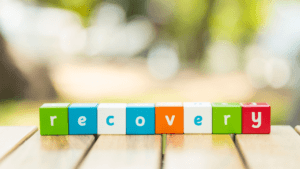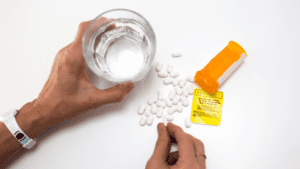For millions of individuals and families across the U.S., opioid use disorder (OUD) is not just a public health issue—it’s a deeply personal battle. Chase Farris’s story is a testament to the struggles and triumphs faced by many in recovery.
Chase’s life took a drastic turn during his senior year of high school when he and his friends began experimenting with opioids. What started as casual use quickly spiraled into a full-blown addiction, leading to financial ruin, broken relationships, and homelessness. After years of struggle, Chase found hope at a rehab facility where he reconnected with his faith and began rebuilding his life. Today, he owns a successful business and continues to share his story of redemption, reminding others that every day is a new opportunity for recovery.
The CDC reports that in 2023, over 81,083 people in the U.S. lost their lives to opioid overdoses, a staggering number largely driven by synthetic opioids like fentanyl. But as Chase’s story shows, with the right treatment and support, recovery is possible.
In this blog, we’ll explore the top treatment options for opioid addiction, from medication-assisted treatment to behavioral therapies, and how those on the recovery path can stay committed to a healthier, addiction-free life. The road to recovery is not easy, but with the right plan and support, it’s possible.
What is Opioid Use Disorder?
Opioid use disorder (OUD) occurs when individuals become dependent on opioid medications—whether prescribed or illicit. It impacts the brain’s reward system, leading to compulsive opioid use despite negative consequences. Recognizing the signs of opioid dependence early on is crucial to starting the recovery journey. Some early warning signs include increased tolerance, withdrawal symptoms, and using opioids in dangerous situations.
Recovery is particularly challenging without a comprehensive treatment plan. But with the right support, recovery is achievable.
Top Opioid Addiction Treatment Options
When it comes to beating opioid addiction, there’s no one-size-fits-all solution. Here’s a look at some of the most effective opioid treatment options available today.
1. Medication-Assisted Treatment (MAT)
Medication-Assisted Treatment (MAT) is widely regarded as the gold standard for opioid addiction treatment. This approach combines FDA-approved medications like methadone, buprenorphine, and naltrexone with behavioral therapies to treat the whole person. According to SAMHSA, MAT helps reduce cravings, alleviate withdrawal symptoms, and stabilize brain chemistry, allowing individuals to regain control of their lives.
MAT programs are often provided through specialized opioid treatment centers, and research shows that people using MAT are more likely to remain in treatment longer and avoid relapse.
2. Naloxone (Emergency Overdose Reversal)
Naloxone is a life-saving medication used to reverse opioid overdoses in emergency situations. Available as a nasal spray (Narcan) or injection, naloxone works by rapidly binding to opioid receptors in the brain, effectively reversing the effects of the overdose. While naloxone doesn’t treat opioid addiction itself, it’s an essential tool in preventing fatal overdoses, giving individuals the chance to seek further treatment.
Many states allow naloxone to be obtained without a prescription, and it’s often carried by first responders and even family members of those at risk. Stopoverdose.org provides a list of locations where naloxone can be obtained, making it easier for communities to access this resource. Its accessibility is key in harm reduction, offering a safety net while individuals pursue long-term recovery options. If you are interested in Naloxone training, don’t hesitate to get in touch with the Rayce Rudeen Foundation.
3. Behavioral Therapies
Medications alone are often not enough. Behavioral therapies like Cognitive Behavioral Therapy (CBT) and motivational interviewing help individuals understand the root causes of their addiction and develop strategies to manage triggers and cravings. These therapies teach coping mechanisms, stress management, and relapse prevention, crucial for long-term success.
3. Holistic Therapies
Beyond medication and traditional therapy, many individuals benefit from incorporating holistic treatments like yoga, meditation, and mindfulness into their recovery. These practices help reduce stress, improve mental clarity, and maintain emotional balance, making them valuable tools for maintaining sobriety.
A 2022 study published in the National Center for Biotechnology Information found that holistic approaches can enhance traditional addiction treatment by promoting overall well-being and helping individuals manage stress and cravings in healthier ways.
How to Find the Right Opioid Recovery Program
When it comes to finding the right treatment center, location matters. Searching for opioid treatment centers near me can help you locate nearby options that provide both inpatient and outpatient care, depending on the severity of addiction. Inpatient programs offer intensive support in a controlled environment, while outpatient programs provide more flexibility for individuals balancing treatment with everyday life.
Many opioid recovery centers provide a full range of services, including medical detox, long-term treatment programs, and aftercare support, which significantly increases the chances of successful recovery. The right center will tailor a treatment plan to your needs, whether it’s focusing on opioid withdrawal medication or developing long-term strategies to maintain sobriety.
Staying Committed to Opioid Recovery
Recovery from opioid addiction is not a one-time event—it’s a lifelong process that requires ongoing effort and support. Here are some proven ways to stay committed to your recovery:
- Build a Support System: Surround yourself with family, friends, and healthcare professionals who understand and support your journey. Research shows that having a strong support network improves outcomes in addiction recovery.
- Participate in Support Groups: Organizations like Narcotics Anonymous (NA) offer ongoing support and accountability through group meetings and mentorship. Studies have shown that individuals who participate in such groups are more likely to stay sober long-term.
- Use Medication as Prescribed: If you’re on a MAT plan, it’s important to stick to your prescribed regimen. Opioid addiction medications like methadone or buprenorphine reduce cravings and prevent relapse, but skipping doses can increase the risk of setbacks. If you experience side effects like opioid-induced constipation, speak with your healthcare provider for solutions.
- Explore Holistic Approaches: Mindfulness practices like yoga, deep breathing exercises, and meditation help maintain mental and emotional stability, which can be crucial during challenging times in recovery.
Access to Opioid Recovery Centers and Programs
Choosing the right opioid recovery center can be the key to long-term success. Many centers offer personalized treatment plans, including opioid withdrawal medication treatment, behavioral therapy, and holistic care options. Centers that offer comprehensive care, from medical detox to aftercare programs, help individuals stay on track with their recovery goals.
Make sure to explore options that fit your needs by searching opioid treatment programs near me or consulting Addiction Help Finder’s treatment locator for trusted recovery centers for Spokane Washington and surrounding areas.
Take the First Step Toward Recovery
Opioid addiction recovery is possible, and it starts with taking the first step. By understanding opioid use disorder treatment guidelines and finding the right support, individuals can start on a journey toward healing. If you or a loved one is struggling with opioid addiction, seek help today. You can start by exploring opioid recovery programs near you or calling a confidential helpline to discuss treatment options.










